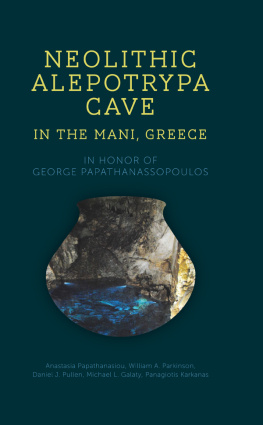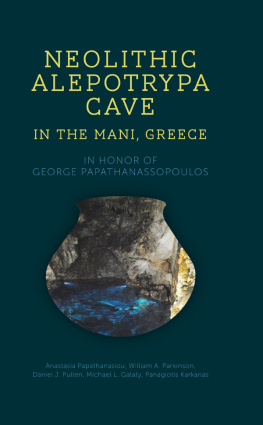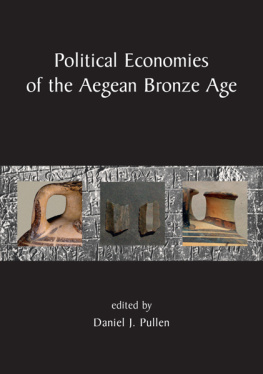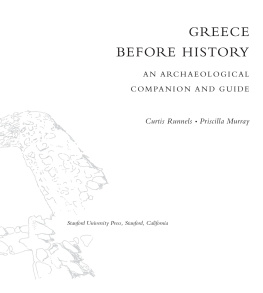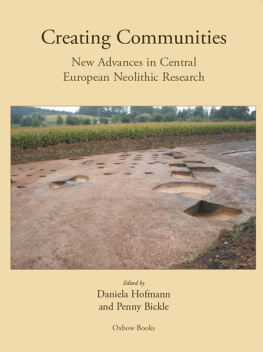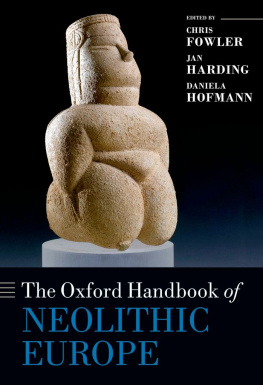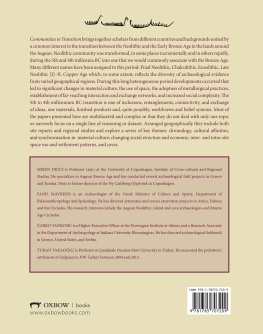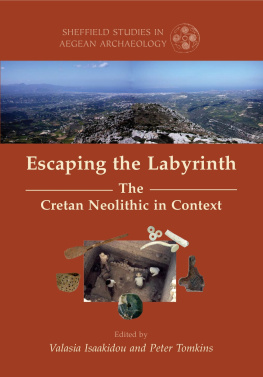
NEOLITHIC ALEPOTRYPA CAVE IN THE MANI, GREECE
I N H ONOR OF G EORGE P APATHANASSOPOULOS
Edited by
A. PAPATHANASIOU, W. A. PARKINSON, D. J. PULLEN, M. L. GALATY, AND P. KARKANAS
Published in the United Kingdom in 2018 by
OXBOW BOOKS
The Old Music Hall, 106108 Cowley Road, Oxford, OX4 1JE
and in the United States by
OXBOW BOOKS
1950 Lawrence Road, Havertown, PA 19083
Oxbow Books and the individual authors 2018
Hardcover Edition: ISBN 978-1-78570-648-6
Digital Edition: ISBN 978-1-78570-649-3 (epub)
Kindle Edition: ISBN 978-1-78570-650-9 (mobi)
A CIP record for this book is available from the British Library
Library of Congress Control Number: 2017956457
All rights reserved. No part of this book may be reproduced or transmitted in any form or by any means, electronic or mechanical including photocopying, recording or by any information storage and retrieval system, without permission from the publisher in writing.
For a complete list of Oxbow titles, please contact:
UNITED KINGDOM
Oxbow Books
Telephone (01865) 241249, Fax (01865) 794449
Email:
www.oxbowbooks.com
UNITED STATES OF AMERICA
Oxbow Books
Telephone (800) 791-9354, Fax (610) 853-9146
Email:
www.casemateacademic.com/oxbow
Oxbow Books is part of the Casemate Group
Front cover: Alepotrypa Cave, the Lake (by Andreas Darlas)

George Papathanassopoulos
List of illustrations
| Figure 0.1. | Alepotrypa Cave floorplan and archaeological loci. Important note: TH (from Thesi) is the equivalent of ( = locus). Th can also be substituted for the chamber designation letter (i.e. Th/20 is the same as /20 or Z/20). Certain loci may also bear specific names. Furthermore, Niche 31 is the same as LA1 or Th/31 or /31. |
| Figure 2.1. | Alepotrypa on the map of Greece. |
| Figure 2.2. | Aerial photo of Diros Bay with Alepotrypa Cave floor plan superimposed |
| Figure 2.3. | First report on the discovery and the name of Alepotrypa Cave (cave number 923) by the Greek Speleological Society |
| Figure 2.4. | Page of G. Papathanassopouloss handwritten note book, on his first visit to Alepotrypa Cave |
| Figure 2.5. | Page of G. Papathanassopouloss handwritten note book, at the beginning of investigation of Alepotrypa Cave |
| Figure 2.6. | Map of the west half of Alepotrypa Cave, with all the numbered activity areas (TH/) |
| Figure 2.7. | Map of the east half of Alepotrypa Cave, with all the numbered activity areas (TH/) |
| Figure 2.8. | Alepotrypa Cave, Chamber A, looking west to the present entrance |
| Figure 2.9. | Alepotrypa Cave, Chamber A, looking east to Chamber B |
| Figure 2.10. | First map of Alepotrypa Cave (cave number 923) by the Greek Speleological Society |
| Figure 3.1. | Plan view of the Alepotrypa Cave, showing the different chambers |
| Figure 3.2. | Plan view of the front chambers |
| Figure 3.3. | Plan view of the back chambers, showing the sampled areas of Chamber Z |
| Figure 4.1. | Plan of the Alepotrypa Cave with Chambers AZ and the individual loci of research |
| Figure 4.2. | Interior of Chamber B |
| Figure 4.3. | Plan of the anterior section of Alepotrypa Cave closest to the entrance |
| Figure 4.4. | Stratigraphy I: The nine layers of Trench B1 (S1S9) as recorded in 1971. |
| Figure 4.5. | Burial |
| Figure 4.6. | Burial |
| Figure 4.7. | Burial |
| Figure 4.8. | Stratum 9. Circular structure in the NE corner with paved bottom |
| Figure 4.9. | Stratum S9. The visible part of the structure on the south side |
| Figure 4.10. | Burial B, SE corner |
| Figure 4.11. | Burial B |
| Figure 4.12. | Burial B |
| Figure 4.13. | Burial C |
| Figure 4.14. | Burial C |
| Figure 4.1519. | Black Burnished ware |
| Figure 4.20. | Dot incised decoration |
| Figure 4.2124. | Rhyton sherds |
| Figure 4.25. | Sherd from multi-legged vessel (Gr51) |
| Figure 4.2629. | Grey Burnished ware |
| Figure 4.3035. | Matt Painted ware |
| Figure 4.36. | Polychrome Ware (Group III) |
| Figure 4.37. | Rippled ware |
| Figure 4.3842. | Pithoid vessels |
| Figure 4.4356. | Ceramic handles and lugs |
| Figure 4.57. | Cheese pots |
| Figure 4.58. | Rolled-rim bowls |
| Figure 5.1. | Ossuary II. Plan of locations and detail of grid in 9 |
| Figure 5.2. | Ossuary II. Plan of locations and detail of grid in 9 |
| Figure 5.3. | Ossuary II. Plain monochrome ware |
| Figure 5.4. | Ossuary II. Plain basins and cheese-pots |
| Figure 5.5. | Ossuary II. Plain basins and cheese-pots |
| Figure 5.6. | Ossuary II. Polished monochrome ware |
| Figure 5.7. | Ossuary II. Polished monochrome ware |
| Figure 5.8. | Ossuary II. Jars with banded decoration |
| Figure 5.9. | Ossuary II. Jars with banded decoration |
| Figure 5.10. | Ossuary II. Dark polished/burnished monochrome ware |
| Figure 6.1. | a) Niche 31 during excavation; b) detail of interior |
| Figure 6.2. | Niche 22 before (a) and after (b) excavation |
| Figure 6.3. | Niche 22a after excavation |
| Figure 6.4. | 20 |
| Figure 6.59. | Pottery from Niche 31 |
| Figure 6.1012. | Pottery from Niche Z22 |
| Figure 6.13. | EN pottery from Chamber Z |
| Figure 6.14. | Pottery with red crusted decoration from 24 |
| Figure 6.15. | FN fluted bowls from 24 |
| Figure 6.16. | MN Collar jars in lime ware |
| Figure 6.17. | MN Urfirnis vessels |
| Figure 6.18. | Black Burnished pottery |
| Figure 6.19. | Grey Burnished pottery |
| Figure 6.20. | Matt Painted pottery |
| Figure 6.21. | Cheese-pot |
| Figure 6.22. | Pottery in coarse and med/coarse ware found throughout Chamber Z |
| Figure 6.23. | Part of a low, collar jar showing affinities with pottery from the Cyclades |
| Figure 7.18. | Pithoid vessels |
| Figure 9.1. | Map of Greece with the sites mentioned in the text. |
| Figure 9.2. | Obsidian cores |
| Figure 9.3. | Obsidian core tablets |
| Figure 9.414. | Obsidian tools |
| Figure 9.15. | Pieces with gloss |
| Figure 9.16. | White patinated pieces |
| Figure 10.16. | Schist passive abrasive tools |

